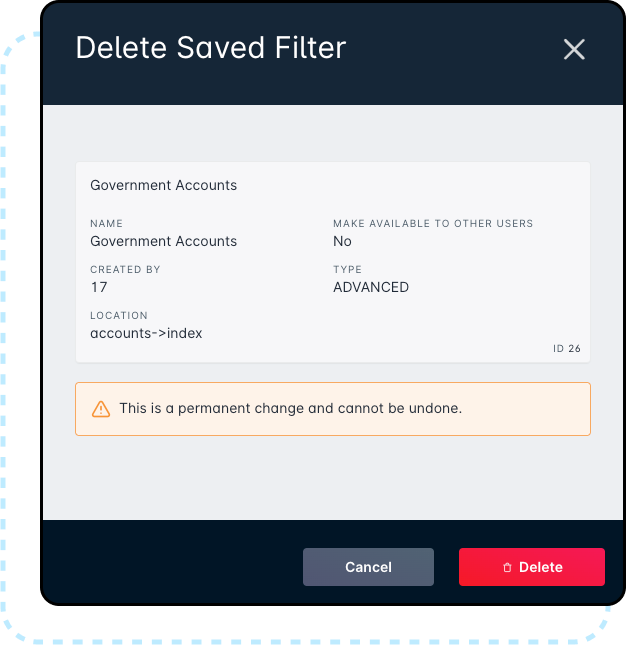Our Products & Services
Getting Started
First Time Setup
Getting Started With Jobs
Getting Started with Accounts
Getting Started with Inventory
Getting Started with Ticketing
Setting Sonar up for Billing
Baseline Configuration
How To: Using Sonar's Customer Portal
User Specific Resources
Accounts
Account Groups: Overview & Example Use Cases
Account List View: Overview
Account Management View: Overview
Account Overview Customization
Account Statuses: Overview & Example Use Cases
Account Types: Overview & Example Use Cases
Anchor & Linked Serviceable Addresses: Overview and Best Practices
Archiving an Account: Overview
CPUC Fixed Broadband Deployment by Address
Child Accounts: Best Practices & How Tos
Creating a New Account
Direct Messages: Overview
Disconnecting an Account
Disconnection Reason Management: Overview
Exploring Task Groups
FCC Broadband Data Collection (BDC) Filings: How Sonar Can Help
FCC Data Exports: General Overview and Usage
Future Serviceable Addresses: Overview
Lead Intake Form Processing
Notes: Best Practices & Use Cases
Scheduled Events: Overview & Use Cases
Serviceable Addresses: Overview and Usage
Specify Account ID upon Creation
Tasks & Task Templates: Overview
Using Sonar's FCC Broadband Label Generation Tool
Billing
ACH Batching: Overview
Accounts in Vacation Mode
Avalara: Overview & Setup
Batch Payments & Deposit Slips: Overview
Billing Calculator
Billing Defaults
Billing Settings
Building Packages
Building a Data Service
Canadian ACH tool
Changing Service Pricing in Sonar: Best Practices
Considerations When Using Avalara with Voice Services
Creating Discounts for Services and Packages
Delinquency Billing Best Practices
Delinquency Exclusions: Overview and Use Cases
Dual Data Services: Overview
Email Invoice Batch: Overview
General Ledger Codes: Overview
General Transactions: Best Practices
How Sonar Prorates Billing
How to Take Bank Account Payments
How to: Adding a Service to an Account
Invoice Templates: Overview
Leveraging PayPal as a Payment Method in Sonar
Manual Transactions
Multi-Month Billing & Multi-Month Services
Print to Mail
Printed Invoice Batches: Overview
Services: Overview
Setting Up Payment Methods and Taking Payments
Setting up Bank Account & Credit Card Processors
Taxes Setup
Usage Based Billing Policies: Overview and Usage
Usage Based Billing Policy Free Periods: Overview and Usage
Using Tax Exemptions - How To
Communication
Communications: Call Logs Overview & Best Practices
Communications: Messages Overview
Email Variables & Conditions
Message Categories: Overview & Use Cases
Phone Number Types: Overview and Use Cases
Saved Messages: Overview
Setting up an Outbound Email Domain
Trigger Explanations
Triggered Messages: Setup
Using Outbound SMS
Using the Mass Message Tool
Companies
How to: Setting Up a Company in Sonar
Managing Multiple Companies in Sonar: Best Practices
Rebranding your Sonar Instance
Financial
Contract Templates
Invoice Attachment Use Cases & PDF Examples
Invoice Messages: Overview & Use Cases
Invoices in Sonar: Examples, Creation & Contents
Integrations
Atlas Digital CORE Integration
Calix Cloud Data Field Mappings
Calix SMx Integration: Overview
CrowdFiber Integration
External Marketing Providers
GPS Tracking Providers: Overview
GoCardless Integration: Overview & Setup
How to Connect Cambium to your Sonar Instance
How to Connect Preseem to your Sonar System
How to: Using Webhooks in Sonar
Integrating with Calix Cloud
RemoteWinBox - Integration with Sonar
Sonar Retain: AI-Powered Customer Retention & Quality Intelligence
The Sonar Field Tech App
Tower Coverage Integration: Overview
VETRO FiberMap V2 Integration: Overview
VETRO FiberMap V3 Integration: Overview
Webhooks in Sonar: Basic PHP Example
iCalendar Integration
Inventory
Inventory List View: Overview
Inventory Model Management: General Overview
Network Inventory: How-to & Usage Guide
Segmentable Inventory: How-to & Usage Guide
Setup of Inventory: Manufacturers, Categories, and Assignees
Tracking and Using Consumable Inventory
Jobs
Applying Task Templates to Jobs
Edit Job Options
Example Jobs & Templates
Geofences: Overview
Job Types: Best Practices
Jobs and Scheduling: Overview
Scheduling How-to: Creating and Booking a Job
Scheduling Week View: Overview
Setting Up Schedules General Overview
Mapping
Misc.
Combining Custom Fields & Task Templates for Information Storage
Custom Fields Overview & Use Cases
Custom Links: Overview
Task Templates Overview & Use Cases
Monitoring
Building Alerting Rotations
Building a Monitoring Template
Poller Troubleshooting
Pollers: General Overview, Deployment Strategy, Build Out & Setup
Networking
Adtran Mosaic Cloud Platform Integration: Overview
Assigning RADIUS Addresses
Assigning an IP Address Using Sonar's IPAM: How to
Automating IP Assignments, Data Rates, and Network Access in Sonar
Building Address Lists
Building RADIUS Groups
Building a Device Mapper
Cable Modem Provisioning
Controlling Customer Speeds with Sonar: General Overview
DHCP Delivery
Data Usage Available Methods
Finding your OIDs
FreeRADIUS 3: Build-Out & Integration
How Sonar Communicates - Egress IPs Explained
IP Assignments & Sonar
IPAM: Basic Setup
IPAM: Overview
LTE Integration
MikroTik as an Inline Device: Integration With Sonar
MikroTik: Controlling Access
MikroTik: Controlling Speeds
MikroTik: Setting Up a Sonar Controlled DHCP Server
Netflow On-Premise Integration: Setup and Overview
Network Dashboard: Overview
Network Sites: Management View Overview
PacketLogic: Integration With Sonar
Pulse, Polling, and PHP
RADIUS: Build-Out & Integration with Sonar
RADIUS: Building Reply Attributes
Setting Up CoA Proxy
Sonar Flow
Sonar IP Addressing
Using Multiple Network Devices in Sonar
Purchase Orders
Release Notes
Reporting
Enhanced Business Intelligence - Tips & Tricks for Advanced Users
How To Enhance Your Reporting With Custom Field Data
Report Licenses
Sonar's Business Intelligence: Overview
Understanding Sonar Reports
Using Sonar DataConnect to Connect BI Applications with Your Sonar Instance
Security
Application Firewall: General Overview and Best Practices
Auth0: Overview
Multi-Factor Authentication: Overview
Password Policy In Depth
Removing a Terminated Employee In Sonar
Role Creation using GraphiQL
User Role Creation & Best Practices
Users: Overview
Sonar Billing
sonarPay
sonarPay Canada Disbursements: Overview
sonarPay Chargebacks & Disputes: Overview
sonarPay Disbursements: Overview
sonarPay Monthly Statement: Overview
sonarPay Overview
sonarPay Reversals, Voids, & Refunds: Overview
sonarPay: Token Migration Process
System
A Deeper Dive into the New Sonar API
API Calls Using Third Party Applications: Personal Access Tokens
Browser Compatibility and Minimum Hardware Requirements for Sonar
Consuming the Sonar API
Controlling Your Landing Page: Personal Preferences
Customizing Your Customer Portal
Date/Time Picker: Overview
Dynamic Time Zones in Sonar
Filtering: Overview
Frequently Used Terms
Getting Your Data into Sonar
GraphQL Rate Limiting Overview
How To Use GraphiQL to Understand the Sonar API
How Your Data is Backed Up
How to Best Use Global Search
Interacting with Files via the API
Introducing the New Sidebar
Main Menu: Overview
Mutations in the Sonar API
Notification Preferences
REST API Wrappers for V1 Compatibility
SMS Notifications
Sonar's Rich Text Editor
System Settings: Overview
The New Sonar API
Troubleshooting the Customer Portal
Upgrading your Ubuntu OS - Customer Portal Upgrades
User Profile: Your Personal User Settings
Ticketing
Advanced Ticketing Features
Canned Replies Examples & Templates
Canned Reply Categories
Exploring Ticket Groups
How Sonar Manages Spam Tickets
How to Integrate Inbound Mailboxes with Slack
Inbound Mailboxes Example Build
Ticket Category Families & Ticket Categories: Overview
Ticket Resolution Reasons: Overview
Ticketing: Overview
Using Parent Tickets
Voice
API Changes for Voice Billing
Best Practices to Remain CPNI Compliant
Billing Voice Services in Sonar
Deploying Voice Services in Sonar
Working With the Sonar Team & Additional Resources
Sonar's Security Practices & Certifications
Sonar and General Data Protection Regulation (GDPR)
Sonar's Security Strategies
Technical Security Overview
Best Practices for Fast Tracking a Support Request
Feedback Portal / Suggest a Feature
Learning with Sonar: Tools and Resources
New Client Training Overview
Sonar Casts Table of Contents
Submitting Bugs vs. Feature Requests
The Sonar Community Forum
The Sonar Status Page
Third Party Customer Support Referrals
Table of Contents
- All Categories
- System
- Filtering: Overview
Filtering: Overview
 Updated
by Jennifer Trower
Updated
by Jennifer Trower
Read Time: 6 mins
Within Sonar, you will come across multiple areas where you are provided the opportunity to filter provided tables. Each table provides you with filter options that pertain to that individual table, which ensures that you have the right tools to view the information you are seeking.
Using Filters
You can begin using filters by entering text into the Search Bar or selecting the Filter icon, providing you the opportunity to select further filtering. Each selection will further narrow down the subset of items you are viewing.

- The Search bar allows for a quick Term Search or Filter selection. Pressing Enter is required to begin the search if you are not using a Filter preset or a Saved Filter.The Filter by: options will change depending on the table which you are filtering within your instance.

- The Filter button will open the Filter editor, which allows you to choose a preset filter and then narrow down the subset items.

- Applied Filters allows you the ability to see the number of filters you have selected for your current view. It also allows you to hover over the number and view what filters are in use, or clear the selection by clicking on the “x”.

- The Save button allows you to save your filter options as a Public Saved Filter or Private Saved Filter.
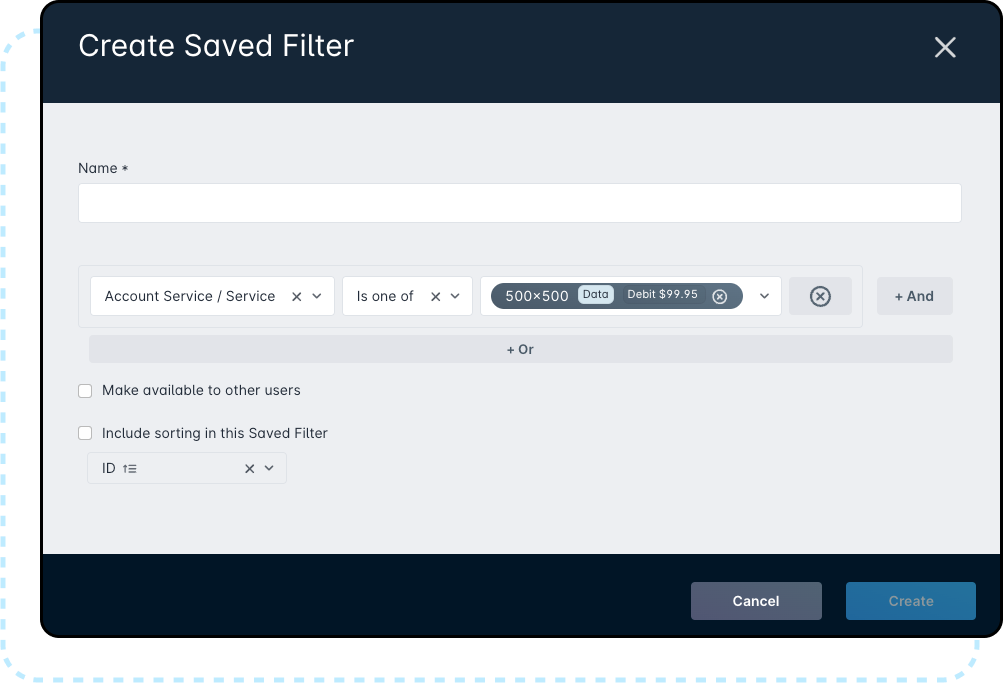

- The Sorter allows you to select how you sort the results of your filtered information.
Using the Filters Menu
Sonar provides you with a simplified view of the Filters available. Clicking on the Icon button → drop arrow in the Choose Filter field, will open the Filters menu, allowing you to see a few different selections for your filtering needs.

- The Saved Filters section provides you with a view of all Public and Private Saved Filters. If permissions are enabled, you can make edits to all Saved filters in this section. If permissions are not enabled, then you can only edit Private Saved Filters.
- The Filters section provides you with a list of more commonly used filters that you can choose from. These filters will change with each table to accommodate the most accurate information necessary for filtering that particular table.
- The Browse More Filters button will open a new pop-up window providing you with a detailed selection of more advanced filter options, which allows you to further narrow down your subset of information you wish to gather.
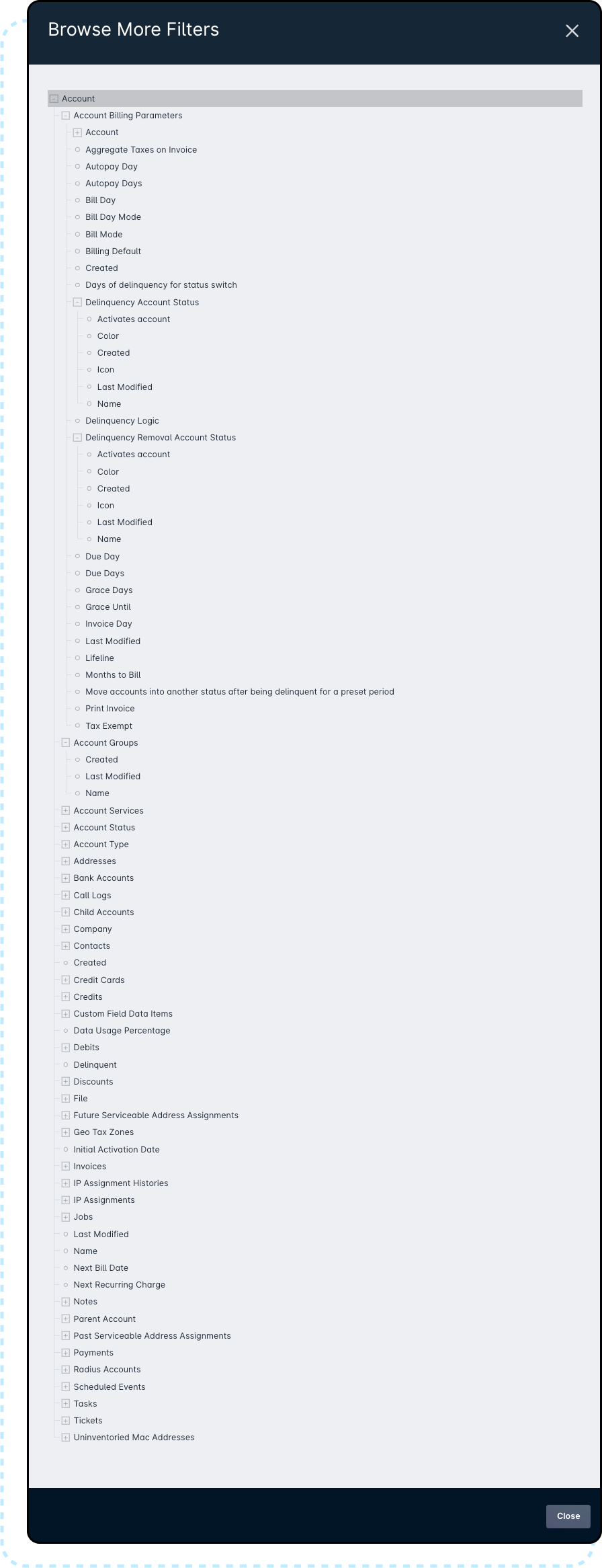
Saving Filters
After you have made your Filter selections, you can save your options by clicking the Save button.

This will open a pop-up window providing you with options for saving your selections.
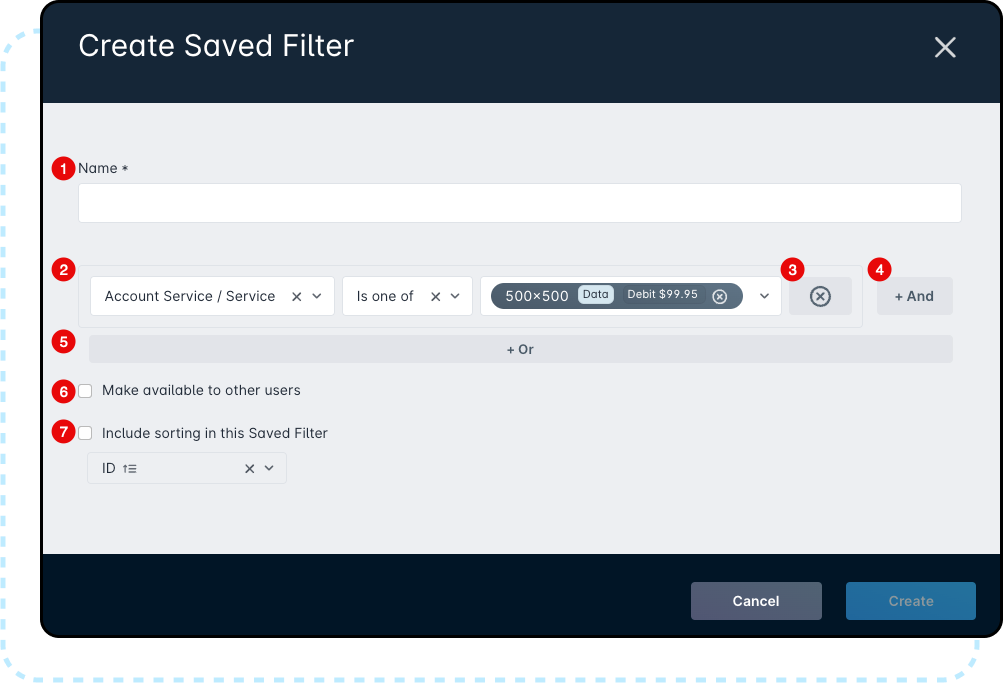
- The Name field is required and allows you to name the Saved Filter.
- The Confirm Filter section provides you with a view of what Filters you have currently selected and want to save. These can be edited within this pop-up window.
- The Delete button will remove the filter row it is associated with from your selected choices.
- The +And button allows you to add another filter option to your selection. When using +And between filter rows, only results that meet the criteria of both filter rows will be shown.

- The +Or button allows you to add another filter option to your selection. When using the +Or between filter rows, results that meet the criteria of either filter row will be shown.

- The Make available to other users checkbox is available to make this Saved Filter a Public Saved Filter.
- The Include sorting in this Saved Filter checkbox is available if you wish to save a particular sorting option with your Saved Filter.
Once you have completed filling out the fields and selecting the optional boxes, click Create to save your Filter.

Permissions
Most features related to saving filters work without any additional permissions given to a user. However, without permissions given, users will be unable to create new, edit existing or delete any public saved filters. All users can create their own new private filters, and edit any of their own filters too.
To adjust these permissions, navigate to Settings → Security → Roles and then select the role you need to modify. With the new menu populated, scroll down to the Misc section and enable the applicable permissions.

Public Saved Filters
To view a complete list of all public filters in your instance, navigate to Settings → Public Saved Filters. From here, you will be able to see the name of the filter, along with the page it is tied to.

If the 'Update a public saved filter' permission is enabled, you can rename any Public Saved Filter by clicking on “Edit”. Any further adjustments required must be done from the page it is tied to, as shown in the 2nd column.
If the 'Delete a public saved filter' permission is enabled, you can remove a Public Saved Filter from your instance by clicking on the “Delete” button. Any users who may have been actively utilizing it will continue to use the same filtering and sorting selections until they either clear their filters or log out.

Updating a Saved Filter
In the event you need to modify an already existing Saved Filter, you would first need to select the Saved Filter. Then, you can make the relevant adjustments to the filters and/or sorting, and click the “Update” button.
In the pop-up window, you will have the option of renaming the filter and confirming your adjustments before saving the changes.
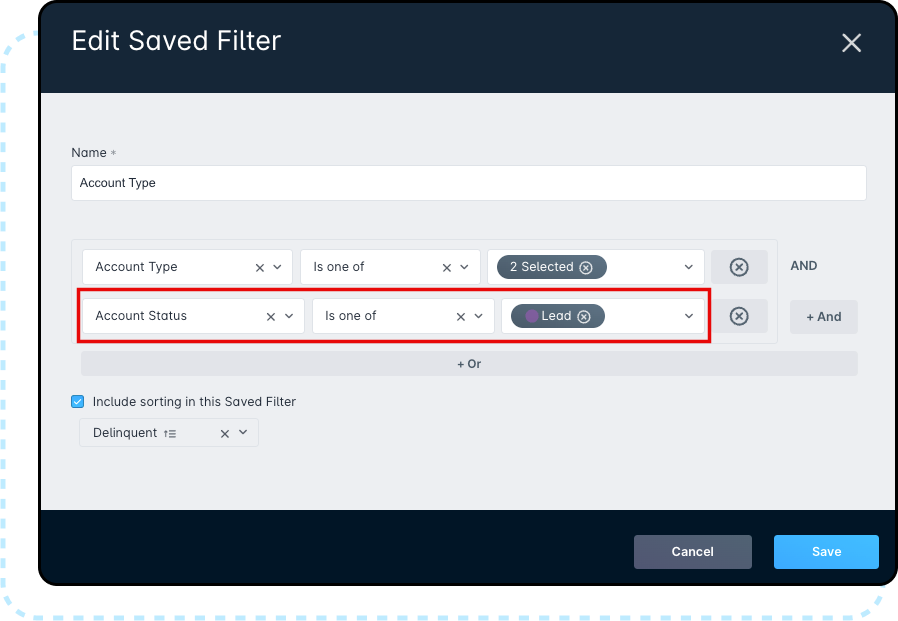

Saving as a New Filter
After selecting the filters you need, you can save your selections by clicking the dropdown arrow next to the Update button. This will open the “Create Saved Filter” pop-up window allowing you to Name the Saved Filter, adjust any of your filter selections, make your Saved Filter available for public viewing, and your sorting preference, if applicable.

Once you have finished selecting from the options provided, click Create.
Deleting a Saved Filter
To delete a Saved Filter, navigate to the Filter button, and click the delete button next to the Saved Filter you wish to delete.

A window will open to confirm you want to delete the selected Saved Filter. Click Delete to confirm.
